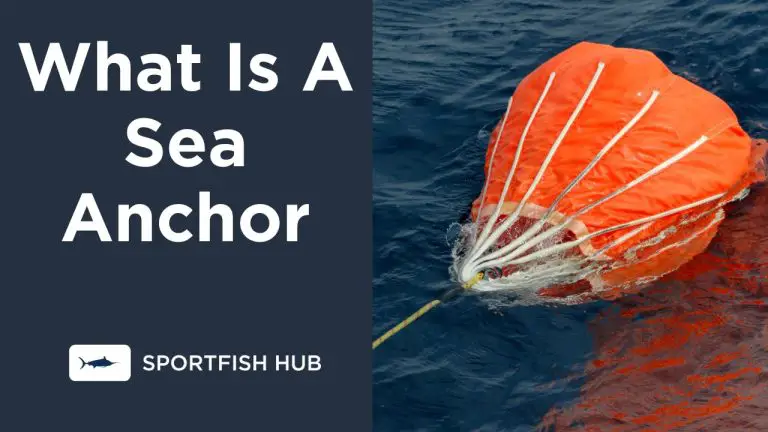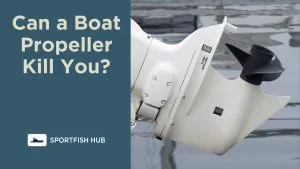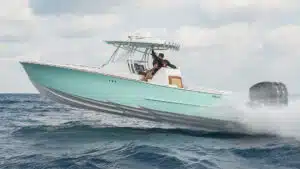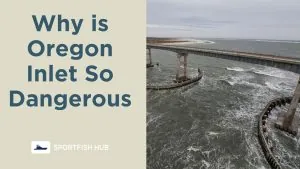Navigating the open ocean can be an exhilarating experience, but it’s crucial to be prepared for any situation Mother Nature throws your way, and she knows how to throw em!
One essential tool that every boater should have in their arsenal is a sea anchor.
In this post, we’ll explore sea anchors – from their purpose and functionality to how they effectively stabilize vessels during poor weather conditions and rough seas.
- What is a Sea Anchor?
- What is a Drogue?
- How To Properly Use A Sea Anchor
- Using a Sea Anchor For Fishing
- Mechanisms And Functionality
- Frequently Asked Questions
- What is the history of sea anchors?
- Are there any alternatives to sea anchors?
- How often should I inspect my sea anchor?
- Can I use a sea anchor in any type of water body?
- What should I do if my sea anchor gets stuck?
- Conclusion
What is a Sea Anchor?
A sea anchor is a device designed to stabilize a vessel in heavy weather by creating hydrodynamic drag. It limits the boat’s progress through the water, acting more as a brake than an anchor tethered to the seabed. The primary function of a sea anchor is to keep the vessel’s bow facing into the waves, reducing the risk of capsizing or broaching.
See Also: How to make your own Sea Anchor.
What is a Drogue?
A drogue, on the other hand, is a cone or funnel-shaped device used to slow down a vessel’s drift speed while still allowing some movement. Unlike a sea anchor, a drogue is often deployed off the stern of the boat. It helps maintain better control during storms by preventing the vessel from surfing or broaching on the face of a wave.
Key Differences Between a Sea Anchor and a Drogue
- Deployment: Sea anchors are typically deployed from the bow of the vessel to keep it pointed into the waves, while drogues are usually deployed from the stern to control speed and prevent surfing.
- Function: Sea anchors aim to keep the vessel as stationary as possible, reducing drift and maintaining orientation. Drogues, however, allow for controlled drift and help manage the vessel’s speed.
- Size and Design: Sea anchors are generally larger and designed to create significant drag, while drogues are smaller and designed to provide a steady, controlled drag.
- Usage Scenarios: Sea anchors are often used in severe weather conditions to maintain the vessel’s position and stability. Drogues are typically used to control speed and prevent broaching or surfing, especially when running before large waves.
How To Properly Use A Sea Anchor
Steps For Deploying And Using A Sea Anchor Effectively
Deploying and using a sea anchor can be the difference between safety and danger in heavy weather conditions. Here are the steps you need to follow to ensure safe and effective deployment of a sea anchor:
- Choose the right sea anchor: Consider factors such as the size, type, and material of the sea anchor based on your vessel’s specifications, expected weather conditions, and water depth.
- Prepare the deck: Clear the deck of any loose objects that could cause damage during deployment. Ensure that all chafe gear is properly installed.
- Deploy the sea anchor: Attach the trip line to one end of the sea anchor rode before tossing it overboard from the bow end of your boat.
- Attach the bridle: Once deployed, attach a bridle to each side of the rode for better stability.
- Position your boat: Keep your boat pointed into wind or into waves while adjusting for drift and tension on bridle lines.
- Monitor progress: Constantly monitor weather and sea conditions through this process so you can adjust or recover if needed.
- Recovering: To recover, start by releasing tension on both sides of the bridle lines then use a retrieval line attached with a buoy to pull it back onboard.
Remember that deploying a sea anchor requires careful preparation, proper equipment knowledge, and skillful execution optimized for weather conditions at hand.
Using a Sea Anchor For Fishing
Using a sea anchor or a drift sock is a popular technique used for fishing in areas with high winds or strong currents, particularly when using live bait.
I actually did this myself with the famous RJ Boyle off the coast of Florida several years back and I can attest to the fact that it works!
Not only does using a sea anchor allow for a more stable fishing platform (Never a bad thing), but it also allows you to position the boat and keep it there.
The obvious benefit to that is that now you can fish more lines with a lower probability of tangling.
Another benefit to fishing with a drift sock is that you can turn off your motors. This not only saves fuel and hours on your engines but also leads to less artificial disturbance and noise in the water, which some anglers believe can drive away certain fish.
Tips For Preparing Before Deploying A Sea Anchor
Before deploying a Sea Anchor, it’s crucial you take the following measures:
- Inspect the Sea Anchor: Thoroughly check the Sea Anchor and its components for any damage or wear. Ensure all lines and attachments are secure.
- Determine Deployment Location: Identify a suitable area to deploy the Sea Anchor, considering potential obstacles that could cause entanglement or damage.
- Calculate Rode Length: Determine the appropriate amount of rode (rope) needed, aiming for at least ten feet per foot of boat to prepare for severe storms.
- Practice Deployment and Retrieval: Familiarize yourself with the proper techniques for deploying and retrieving the Sea Anchor. Practice beforehand to become comfortable with the process.
- Prepare Additional Equipment: Have essential equipment readily available, such as extra lines, floats, scissors, or knives, to facilitate quick and efficient responses during emergencies.
Types Of Sea Anchors And Their Functions
There are several types of sea anchors, which are devices used to stabilize a vessel and limit its progress through the water in heavy weather. The main types of sea anchors include:
- Traditional Sea Anchor: This type of sea anchor is designed to fix a boat in place, much like a conventional anchor, and is used to handle heavy weather by bringing the boat end-on to the waves and limiting drift.
- Parachute Sea Anchor: A para-anchor is a large-diameter parachute system used to “anchor” a boat in water too deep for ground tackle. It is designed to provide sufficient power to hold the bow of a vessel head to wind in the worst storm conditions, reducing the risk of broaching, capsizing, or rolling and keeping the boat more comfortable and stable throughout the duration of the heavy weather.
- Drogue: A drogue is a device deployed off the stern of a boat and is used to keep the boat straight while motoring down-sea. Slowing the boat as it races down a wave face reduces the chance for broaching or pitchpoling; a drogue may also be used to steer a boat that has lost its steering system.
- Drift Sock: A drift sock is a cone-shaped fabric device that creates drag when deployed in the water. It is used to slow down a boat’s drift, particularly when fishing, to maintain a specific position relative to the current or wind.
- Jordan Series Drogue: This type of drogue consists of a series of small cones attached to a line deployed off the stern of a boat. It is designed to provide a more consistent and gradual resistance to the boat’s movement, reducing the risk of broaching or pitchpoling in heavy weather.
Mechanisms And Functionality
How Does A Sea Anchor Work To Stabilize A Vessel?
A sea anchor functions by harnessing hydrodynamic drag, offering stability to a boat when confronted with rough sea conditions. When correctly deployed, the parachute-like shape opens up, generating water resistance that counteracts the forces of the waves, ensuring the boat remains steady.
The effectiveness of this type of anchor relies on its size and design, which should be proportionate to the vessel it aims to stabilize. Larger vessels typically require a bigger sea anchor with increased underwater surface area, providing enhanced resistance and stability for heavier boats in turbulent seas.
Advantages And Disadvantages Of Using A Sea Anchor
Understanding the advantages and disadvantages of using a sea anchor is crucial for boating enthusiasts, sailors, and individuals interested in maritime activities. The following table outlines the pros and cons of using this type of anchor to help you make an informed decision:
| Advantages | Disadvantages |
|---|---|
| Stabilizes a vessel during heavy weather | Requires proper sizing for the vessel to function effectively |
| It can be difficult to deploy and retrieve in rough conditions | Potential for entanglement with underwater structures or debris |
| Keeps the bow windward into the waves | It may not be as effective in shallow water or close to shore |
| Slows down drift in emergency situations | Requires regular inspection and maintenance to ensure the functionality |
| Ensures safety at sea by preventing capsize or broaching | Requires regular inspection and maintenance to ensure functionality |
Factors To Consider When Selecting A Sea Anchor
When choosing a sea anchor for your vessel, it’s important to take into account several key factors to ensure its optimal performance in challenging weather conditions:
- Vessel Size: Consider the size and weight of your boat to select a sea anchor that can effectively stabilize it.
- Type: Different types of sea anchors, such as parachute anchors, drift anchors, and marine drogue parachutes, offer varying advantages and disadvantages. Choose the one that best suits your needs.
- Water Depth: The depth of the water you’ll be navigating influences the length of the rode (anchor line).
- Weather Conditions: Assess the expected weather conditions to determine the appropriate type and size of the sea anchor that can handle the anticipated challenges.
- Strength and Quality: Ensure the sea anchor is made of durable and high-quality materials to withstand the forces exerted by rough seas.
- Ease of Deployment: Select a sea anchor that is easy to deploy, especially during emergency situations where time is of the essence.
- Cost Consideration: While cost is a factor, prioritize value for money by balancing affordability with the sea anchor’s quality and effectiveness.
When To Use A Sea Anchor: Weather And Sea Conditions, Emergency Situations
- Emergency Situations: When faced with an emergency at sea, such as engine failure or loss of control, deploying a sea anchor can help stabilize the vessel and prevent drifting.
- Rough Weather Conditions: In heavy seas, strong winds, or stormy weather, a sea anchor can provide stability by reducing drift and maintaining the vessel’s position.
- High Waves and Breaking Seas: When waves begin breaking over the deck, making it difficult to steer and maintain control, deploying a sea anchor can help prevent capsizing and maintain stability.
Frequently Asked Questions
-
What is the history of sea anchors?
The use of sea anchors dates back to ancient times when sailors used stones, sand-filled bags, or logs attached to ropes to slow their vessels.
-
Are there any alternatives to sea anchors?
Yes, drogues are often used as an alternative to sea anchors. They are designed to slow a boat’s speed in the water rather than stop it completely.
-
How often should I inspect my sea anchor?
It’s recommended to inspect your sea anchor before each use and at least once a year for any signs of wear and tear.
-
Can I use a sea anchor in any type of water body?
Sea anchors are primarily designed for use in open water where there is sufficient depth. They may not be as effective in shallow water or close to shore.
-
What should I do if my sea anchor gets stuck?
If your sea anchor gets stuck, you should try to retrieve it using the trip line. If this is not possible, you may need to cut the line.
Conclusion
In conclusion, a sea anchor is an essential device for boaters and sailors who want to stay safe while navigating through heavy weather conditions. It helps stabilize the boat by providing hydrodynamic drag, acting as a brake rather than tethering the boat to the seabed.
The device comes in different types and sizes, depending on specific needs, and easy deployment is ensured by high-strength nylon fabric reinforced with webbing. While it’s important to consider various factors before choosing between a sea anchor or drogue, understanding their functions can make all the difference when dealing with challenging marine situations.













